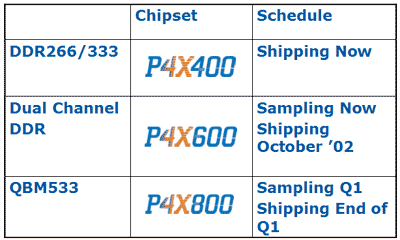VIA Introduces Quad Band Memory - 2X DDR at 1X Prices
by Anand Lal Shimpi on September 17, 2002 1:49 PM EST- Posted in
- CPUs
Final Words: Thinking about QBM
VIA's first chipset to support QBM will be the P4X800 for the Pentium 4; the chipset will begin sampling in Q1-2003 and it will ship by the end of Q1-2003. Unfortunately this in itself may limit the success QBM sees; we've already established that motherboard makers won't touch VIA's renegade Pentium 4 chipset because of pressure from Intel, and even though QBM is a tempting technology we have our doubts that it will be what causes players like ASUS and MSI to go against Intel's wishes. The QBM technology itself is licensed from Kentron Technologies, so in theory SiS could obtain a license to produce their own QBM enabled chipsets should the technology take off.

The obvious benefits of QBM are very low cost of (motherboard) implementation and instant doubling of memory bandwidth. Unfortunately VIA is at the mercy of the memory manufacturers when it comes to getting QBM off the ground; both Elpida and Infineon have signed on as providers but it's going to take more than that for QBM to gain mainstream success (the support of two manufacturers is exactly what RDRAM had remember?). QBM modules will obviously be more expensive than regular DDR modules, the question of how much remains to be answered however.
The technology is interesting but as is often the case, it's going to take more than neat technology to get QBM off the ground. With SiS making heavy gains in the Pentium 4 chipset market, VIA needs to do all it can to regain some of that Intel platform market share it lost when the Pentium III was phased out.










0 Comments
View All Comments